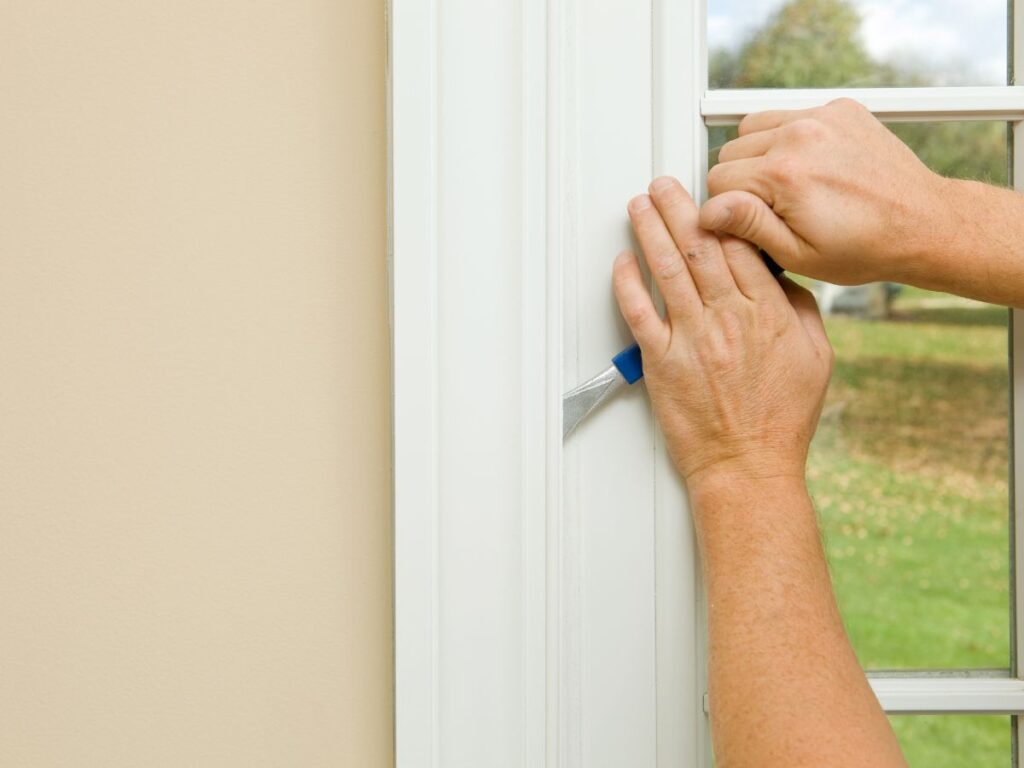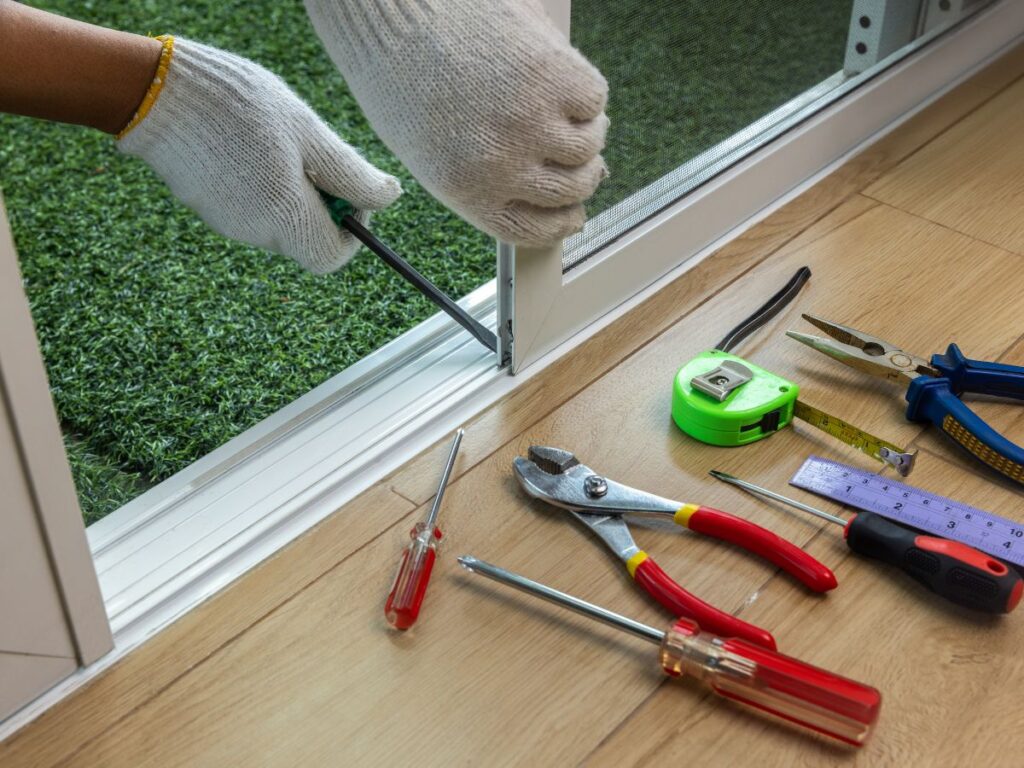Have you ever had a project delayed because no one knew how to remove a patio door? I’ve seen it happen more than once.
On one hotel renovation, the team stood around for hours before calling me in to help.
I’ve been working with engineers and property owners on door and window projects for years, so I know what works and what doesn’t.
In this article, I’ll share a clear, step-by-step guide to removing a patio door safely and efficiently. By the end, you’ll have a process you can use right away.
Removing a patio door doesn’t have to stop your project in its tracks.
So, let’s dive in!
Quick Guide
Before we jump into the full details, here’s a quick glimpse of the steps involved. This table will give you the overall flow of how we remove patio doors safely and professionally.
| Steps | Key Actions | Why It Matters | Mistakes To Avoid |
| Step #1: Prepare the Work Area | Clear space, cover floor, tape glass | Avoid mess and damage | Skipping prep, working in clutter |
| Step #2: Remove the Interior Trim | Score edge, pry slow, mark pieces | Protects trim and wall | Pulling fast, damaging drywall |
| Step #3: Remove Sliding/Hinged Panel | Unscrew, lift with help, tilt gently | Prevents cracks or breaks | Lifting alone, tilting too far |
| Step #4: Remove the Fixed Panel | Cut sealant, remove stops, lift clean | Keeps panel intact | Forcing without clearing tracks |
| Step #5: Cut Sealant and Caulk | Score slowly, work in sections, clean edge | Protects wall and frame | Cutting deep, missing spots |
| Step #6: Unscrew the Door Frame | Locate screws, remove slow, bag parts | Frees frame without damage | Stripping screws, skipping fasteners |
| Step #7: Lift Out the Door Frame | Loosen edges, lift level, place flat | Safe removal, frame stays intact | Twisting, dragging, lifting solo |
| Step #8: Clean and Inspect the Opening | Remove debris, check wood, measure again | Preps for new install | Skipping cleanup, poor inspection |
Now that you’ve seen the outline, let’s walk through each step in detail.
Step#1 Prepare the Work Area
I’ve learned over the years that the job always goes smoother if the space is set up right before anyone touches the door. Skipping prep usually means someone ends up frustrated or dealing with damage that could have been avoided. That is why I always treat this first step seriously.
Clear the Space Before You Start
- Remove Furniture: Move anything near the patio door, even if it seems out of the way. Once the glass comes out, every bit of space matters.
- Protect the Floor: A simple drop cloth or sheet saves you from scratched flooring and hours of sweeping up debris.
- Keep Pathways Open: Your crew needs a clean exit path. I have seen teams try to carry glass through clutter, and it never ends well.
Get Your Team and Tools Ready
- Have Enough People: Patio doors look manageable, but they are heavier than most expect. Always plan for at least two sets of hands.
- Gather Tools: I have seen projects lose momentum because someone had to go back for a missing pry bar. Keep everything ready.
- Do a Quick Check: Take a moment to review the setup before starting. That small pause often prevents big mistakes later.
Preparing the work area may not feel exciting, but it shapes how the rest of the project goes. With a clear space, the right tools, and enough hands ready, your team sets itself up for an easier and safer removal.
Step#2 Remove the Interior Trim
This is the step where patience really matters. If your team pushes too fast, trim can crack, walls can chip, and suddenly the job costs more time and money. I’ve been in that situation before, and I teach my crews to slow down here for a reason. When the trim comes off clean, the rest of the door removal is so much easier.
Work Carefully with the Trim
- Start at the Edge: Always cut the paint seal with a utility knife first. It prevents the trim from tearing away and damaging the wall.
- Use the Right Tool: A flat pry bar is the right choice here. It gives you control and protects the surrounding surfaces.
- Apply Even Pressure: Teach your crew not to yank from one spot. Work around the trim slowly, and you’ll keep the piece intact for reuse.
Keep the Pieces Organized
- Label the Trim: I recommend marking each piece with painter’s tape. It makes reinstalling simple and avoids confusion later.
- Stack Safely: Lay the pieces flat or lean them neatly against a wall. That small step keeps them from bending or breaking before reuse.
- Set Aside Nails: Collect nails and screws in a container. It keeps the site clean and prevents anyone from stepping on stray hardware.
This is where teaching your team pays off. If everyone understands why careful trim removal matters, you get faster progress, fewer mistakes, and a smoother job overall. Clean trim is one of those details clients notice, and it reflects well on the whole crew.

Step#3 Take Out the Sliding or Hinged Panel
With the trim out of the way, the panels are next. This part can feel straightforward, but it’s also where I’ve watched projects slip up. A panel that looks easy to move can surprise you with its weight, and handling it wrong can leave you with a cracked glass or bent track. That is why this step deserves a careful approach.
Removing a Sliding Panel
- Lift and Tilt: Most sliding panels come out by lifting upward and then tilting the bottom out of the track. It’s about steady movement, not force.
- Watch the Track: Pay attention to the lower track as you lift. Dragging across it can leave scratches or dents.
- Work in Pairs: Two people make this step safer. One can lift while the other steadies the panel.
Removing a Hinged Panel
- Check the Hinges: Look for screws or pins that need to be pulled before you start lifting. Skipping this step only causes frustration.
- Support the Weight: Hinged panels are heavier than they look. Have someone holding steady while the hardware comes off.
- Carry Out Safely: Once the panel is free, move it along a clear path. Rushing here is how glass accidents happen.
For me, this is the point where good coordination shows. When a crew handles panels smoothly, the whole job feels more controlled and professional. That kind of teamwork leaves the client confident in the work you deliver.
Step#4 Remove the Fixed Panel
This is the part I always remind crews not to underestimate. A door frame looks simple once the screws and sealant are gone, but it can still feel awkward and heavy. I’ve been in projects where the frame twisted mid-lift, and repairing that mistake cost more time than the removal itself. That’s why I always stress teamwork and steady handling here.
Plan the Lift Before Moving
- Have Enough Hands: Frames are bulky. Two people at least, sometimes three, depending on the size.
- Choose the Direction: Decide in advance where the frame will go once it’s free. Nothing slows progress more than standing there with it in your hands, unsure where to set it down.
- Protect Surrounding Surfaces: Keep drop cloths or padding nearby. If the frame bumps into a wall or floor, you avoid damage.
Remove the Frame Smoothly
- Work Top to Bottom: Tilt or lift gently from the top first. This takes pressure off the sill and makes the frame easier to move.
- Keep It Steady: Don’t rush. Hold the frame level and move together as a team.
- Set It Aside Safely: Place it flat or upright against a solid surface, out of the way of foot traffic.
I know, this step is about control and coordination. When the frame comes out in one smooth motion, it shows discipline in the crew and confidence in the work. That kind of finish leaves the right impression on the client.

Step#5 Cut Through Sealant and Caulk
This is the step that separates a smooth removal from a struggle. I’ve worked on sites where crews tried to pull the frame without cutting the sealant, and all they did was bend metal and waste time. It’s a small detail, but it makes all the difference in how cleanly the frame comes out.
Break the Seal the Right Way
- Look for Multiple Layers: On older doors, there may be several bead lines from past repairs. Identify which ones bond the frame directly, but I want you to know that Vallisco doors use precise sealing and durable materials to help prevent repeated repairs over time.
- Use a Sharp Blade: A utility knife with a fresh blade slices through caulk in one pass. Dull blades drag and make the job harder.
- Follow Every Edge: Run the knife along all sides of the frame. Missing even a short section keeps the frame locked tight.
- Work with Patience: Don’t force it. A careful, steady cut is faster in the long run than wrestling with stuck sealant.
Why It Matters
- Keeps the Frame Intact: Cutting the sealant first lets the frame release without twisting or bending.
- Cleaner Finish Later: When you reinstall or replace, the opening looks sharp instead of torn up.
- Safer for Your Crew: Fighting a sealed frame is where accidents happen. A clean release keeps the process under control.
I’ve learned to treat this step as preparation, not just cutting caulk. Once the seal is broken, everything that follows becomes easier, safer, and more professional. It’s the kind of detail that shows the difference between rushing a job and doing it right.
Step#6 Unscrew the Door Frame
By this point, the sealant is cut and the frame is loose, but it’s still locked in place by screws. This is where I like to slow things down. It’s easy to get impatient and start pulling, but that usually ends with stripped heads or bent metal. Taking a steady approach makes the next lift far smoother.
Expose the Fasteners First
- Look Closely: Screws hide in plain sight, often under paint or plastic caps. A careful scan keeps you from missing one and wondering why the frame won’t budge.
- Remove Covers Gently: A putty knife does the trick. Press too hard and you leave marks that the client will notice later.
- Check Weatherstripping: It’s common for screws to sit behind it. A light cut with a knife uncovers them without ripping the strip apart.
Remove Screws in Control
- Pick the Right Bit: Ever tried to back out a screw with the wrong driver? It strips the head instantly. Matching the bit makes everything easier.
- Work Evenly Around: I usually loosen the sides first, then the head and sill. Leaving one or two screws in until the end keeps the frame steady.
- Keep Hardware Together: Tossing screws on the floor is how they get lost. A simple container nearby keeps things organized and safe.
This part is less about muscle and more about control. When your team takes screws out smoothly and nothing breaks or strips, the whole project feels more professional. It’s a small step, but it sets up the frame to come out clean in the very next move.
Step#7 Lift Out the Door Frame
This is the part that usually feels like a milestone. Once the screws are out, the frame is finally ready to come free. But here’s the thing: frames can still feel awkward and heavier than expected.
I’ve watched teams celebrate too early, only to twist the frame on the way out. That’s when damage happens, and nobody wants to explain to a client why a replacement is needed before the new door even goes in.
Plan Before You Lift
- Have Enough Hands: A frame is bulky. Two people minimum, sometimes three if the door is oversized.
- Decide the Path: Talk it through with your team first. Know where you’re setting the frame down before you start moving it.
- Protect Surfaces: Drop cloths or padding nearby make a difference. A quick bump against a wall or floor can leave a mark.
Move It Out Smoothly
- Work From the Top: Tilt the top free first. It takes pressure off the bottom and makes the lift more controlled.
- Keep It Level: Move together at the same pace. Sudden jerks or one person rushing ahead puts stress on the frame.
- Store It Safely: Lay the frame flat or rest it against something solid, well out of the work zone.
For me, this is the step that shows the difference between a crew that just “gets it done” and one that does it right. A smooth, steady lift tells the client their project is in good hands. It’s not about speed here, it’s about control and teamwork.

Step#8 Clean and Inspect the Opening
Once the frame is out, the hard part is done. But I never walk away at this stage. A clean and inspected opening tells me the project is ready for the next step, whether it’s installing a new door or sealing the space temporarily. Skipping this part is like leaving loose ends that will come back later.
Clean the Space Properly
- Clear Out Debris: Sweep up splinters, caulk, and old fasteners. It makes the site safer and more professional.
- Scrape Off Old Sealant: A putty knife works well. Smooth edges prepare the opening for a cleaner fit when the new door goes in.
- Vacuum or Wipe Down: Dust and grit left behind can interfere with installation. A quick cleanup goes a long way.
Check the Condition of the Opening
- Look for Damage: Check the sill and jambs for cracks or rot. Small issues are easier to fix now than later.
- Confirm the Level: A level opening means less trouble aligning the new frame.
- Assess Moisture or Wear: If the opening shows water damage, take note before moving forward.
I see this step as a kind of reset. You clear away what’s old, check what’s left, and make sure the space is ready for what comes next. It’s not just cleanup, it’s your chance to hand over a site that looks cared for and prepared. This is also the point where I often recommend Vallisco doors, since their frames are consistent and make the next installation smoother.
Clients notice details like this, and they remember the teams that leave things better than they found them.
Conclusion
That hotel project I mentioned in the beginning taught me something important. A stuck patio door doesn’t have to delay an entire job if you have the right steps in place.
From preparing the work area to removing the frame and cleaning the opening, each move builds on the last.
If you’re planning to replace a patio door, choosing a reliable manufacturer makes the next step even smoother. Vallisco doors offer consistency crews appreciate on-site.
Contact us today for durable solutions you can count on!
Explore Related Resources
If you enjoyed this read, here are a few more articles packed with helpful information:
Still haven’t found what you’re looking for? Don’t hesitate to contact us. We’re available around the clock to assist you.







